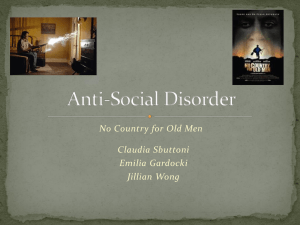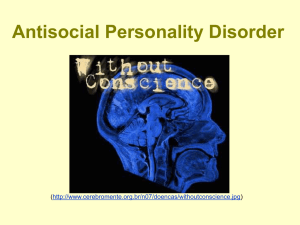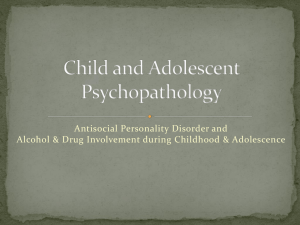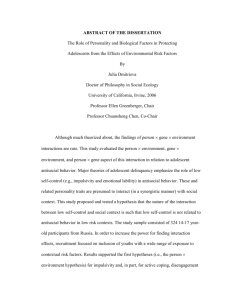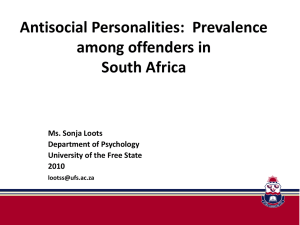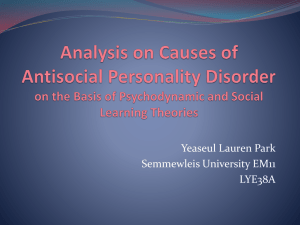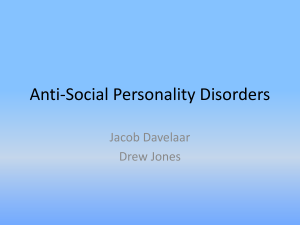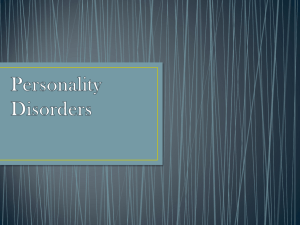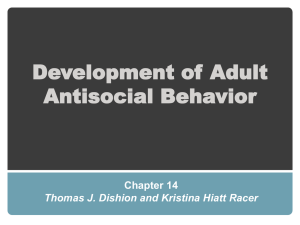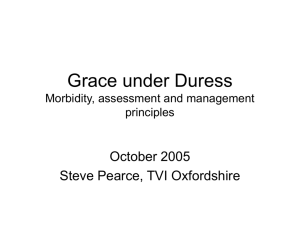Antisocial Personality Disorder
advertisement
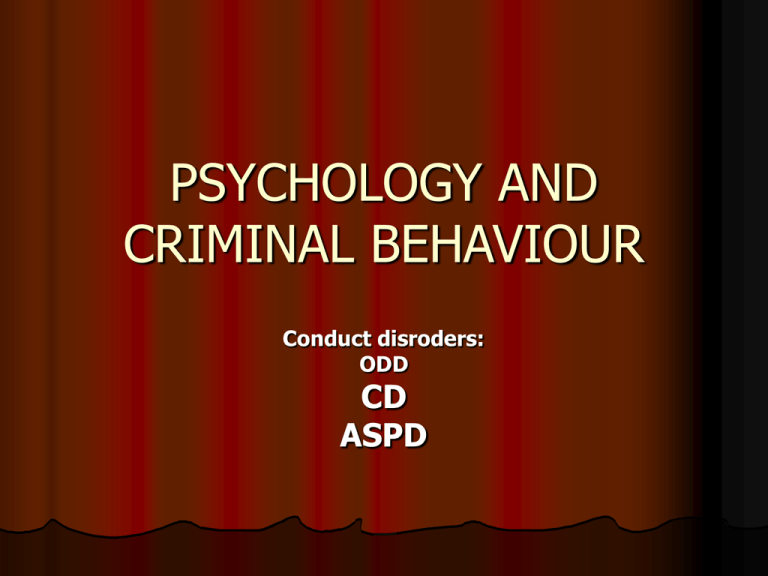
PSYCHOLOGY AND CRIMINAL BEHAVIOUR Conduct disroders: ODD CD ASPD Conduct Problems Age-inappropriate actions and attitudes that violate family expectations, societal norms, or property rights of others Several different types and pathways Often associated with extremely unfortunate family and neighborhood circumstances Context of Antisocial Behavior Antisocial acts relatively “normal” among children Range of severity, from minor disobedience to fighting Most antisocial behaviors decline during normal development, with the exception of aggression More common in boys in childhood, but relatively equal by adolescence Social and Economic Costs of Conduct Problems Antisocial behavior is the most costly mental health problem An early, persistent, and extreme pattern of antisocial behavior occurs in about 5% of children, and these children account for over half of all crime and about 1/3 of clinic referrals Legal Perspectives Conduct problems defined as delinquent or criminal acts resulting in apprehension and court contact Minimum age of responsibility is 12 -1416 Only a subgroup of children meeting legal definitions also meet definition of a mental disorder Psychological Perspectives Conduct problems seen as falling on a continuous dimension of externalizing behavior Externalizing behavior seen as consisting of several related but independent sub-dimensions: delinquent-aggressive overt-covert destructive-nondestructive Psychological Perspectives (cont.) Four categories of conduct problems Psychiatric Perspectives Conduct problems viewed as distinct mental disorders based on DSM symptoms In the DSM-IV, conduct problems fall under the category of disruptive behavior disorders, and include oppositional defiant disorder and conduct disorder Oppositional Defiant Disorder (ODD) Age-inappropriate stubborn, irritable, and defiant behavior, including: losing temper arguing with adults active defiance or refusal to comply deliberately annoying others blaming others for mistakes or misbehavior being “touchy” or easily annoyed anger and resentfulness spitefulness or vindictiveness Conduct Disorder (CD) A repetitive and persistent pattern of violating basic rights of others and/or age-appropriate societal norms or rules, including: aggression to people and animals such as bullying, threatening, fighting, physical cruelty, using a weapon destruction of property, including deliberate fire setting deceitfulness or theft, including “conning” others, forgery, shoplifting, breaking into others’ property serious violations of rules, such as running away, truancy, staying out at night without permission Conduct Disorder (cont.) Childhood versus adolescent onset CD Children with childhood onset CD display at least one symptom before age 10 more likely to be boys are aggressive account for a disproportionate amount of legal activity persist in antisocial behavior over time Conduct Disorder (cont.) Children with adolescent onset CD as likely to be girls as boys do not show the severity or psychopathology of the early-onset group less likely to commit violent offenses or persist as they get older Conduct Disorder (cont.) CD and Antisocial Personality Disorder (APD) as many as 40% of children with CD later develop Antisocial Personality Disorder a pervasive pattern of disregard for, and violation of, the rights of others, as well as engagement in multiple illegal acts Associated Characteristics Cognitive and verbal deficits normal IQ, but generally 8 points lower than peers deficits present before conduct problems deficits in executive functioning School and learning problems underachievement, especially in language and reading relationship often best accounted for by presence of ADHD The School Academic performance and delinquency The general path towards occupational prestige is education, and when youth are deprived of this avenue of success through poor school performance there is a greater likelihood of delinquent behaviour (Singer and Jou, 1992) Poor academic performance has been directly linked to delinquent behaviour School failure is stronger predictor of delinquency than personal variables School failure commonly found among chronic offenders (Farrington and West, 1988) Supported by studies of prison inmates Causes of school failure Social class Streaming Alienation of students from the school experience – lack of attachment Irrelevant curriculum Labeling within the school system Negative interaction with teachers and school officials Associated Characteristics Inflated and unstable self-esteem Peer problems verbal and physical aggression toward peers, may become bullies often rejected as they get older involvement with other antisocial peers underestimate own aggression, overestimate others’ aggression often a lack of concern for others Older peers “The people I hang around with used to like me because I was good at stealing. Because I was young nobody would suspect me and then I would get away with it. They liked to have me stay with them and I liked to be with them because I felt good.” Co –offending declines steadily from age 10 (Reiss and Farrington, (9991) Delinquent friends are likely to have most influence when they have high status within the peer group and are popular Associated Characteristics Health-Related Problems rates of premature death 3-4 times higher higher risk of personal injury and illness early onset of sexual activity, higher sexrelated risks substance abuse, higher risk of overdose Co-morbid Disorders ADHD Depression & anxiety Prevalence & Gender Differences Prevalence 2%-6% for CD; 12% for ODD Gender differences in childhood, antisocial behavior 3-4 times more common in boys differences decrease/disappear by age 15, due to increase in covert non-aggressive antisocial acts in girls for girls, lifetime prevalence for severe conduct problems about 3% Developmental Course Earliest sign usually difficult temperament in infancy Two Pathways Life-course-persistent (LCP) path begin at an early age and persists into adulthood Adolescent-limited (AL) path begins around puberty and ends in young adulthood (more common and less serious than LCP) Often negative adult outcomes, especially for those on the LCP path Three Pathways to Boys’ Disruptive Behavior and Delinquency Source: Thornberry, Huizinga, & Loeber, 2004. U.S. Department of Justice: Juvenile Justice Developmental Course (cont.) Approximate ordering of the different forms of disruptive and antisocial behavior from childhood through adolescence Causes of Conduct Problems Genetic Influences difficult early temperament or impulsivity may predispose certain children adoption and twin studies support genetic contribution, especially for overt behaviors “reward dominance” has been linked to a possible genetic deviation some children may have “reward deficiency syndrome”, which has been linked to a variant form of the dopamine D2 receptor gene Causes of Conduct Problems Neurobiological factors overactive behavioral activation system (BAS) and underactive behavioral inhibition system low psychophysiological and/or cortical arousal, and autonomic reactivity- may lead to diminished avoidance learning higher rates of neurodevelopmental risk factors childhood exposure to lead neuropsychological deficits Causes of Conduct Problems Social-Cognitive Factors egocentrism and lack of perspective taking inability to use verbal mediators to regulate behavior hostile attributions to ambiguous stimuli deficits in stages of social informationprocessing Causes of Conduct Problems Family Contributions Coercion Theory- through an escapeconditioning sequence the child learns to use increasingly intense forms of noxious behavior to avoid unwanted parental demands insecure parent-child attachments family instability and stress parental criminality parental psychopathology Causes of Conduct Problems Societal Influences more common in neighborhoods with criminal subcultures, frequent transitions, low social support among neighbors established correlation between media violence and antisocial behavior Cultural Factors associated with minority status, but this is likely due to low SES Treatment Generally, few effective interventions Interventions with some empirical support: Parent-Management Training (PMT) Cognitive problem solving skills training (PSST) Multisystemic treatment (MST) Mixed findings regarding the effectiveness of medications- may be useful to reduce overt behaviors, must be used in combination with other interventions Personality Disorders Personality Disorders refer to long-standing, pervasive and inflexible patterns of behavior Depart from cultural expectations Impair social and occupational functioning Cause emotional distress Paranoid, Schizoid, Antisocial, Borderline, Narcissistic, Histrionic, Avoidant, Dependent Antisocial Personality Shows a pervasive pattern of disregard for, and violation of other people’s rights. Up to 3.5% manifest an antisocial personality disorder (APA, 1994) Symptoms: Repeatedly deceitful, irresponsible with money, impulsive, tendency to start fights, egocentric, no regard for safety of self or others. Dramatic/Erratic Cluster Antisocial personality disorder (PD) involves The presence of conduct disorder before the age of fifteen Conduct disorder includes truancy, lying, theft, arson, running away from home and destruction of property The continuation of these behaviors into adulthood Prevalence of antisocial PD is about 3% of men and 1 % of women Antisocial Personality Tend to be skillful at manipulating people. Are not distressed by the pain they cause, often perceived as lacking any moral conscience. “They glibly rationalize their actions by characterizing their victims as weak and deserving of being conned or stolen from” (Comer, 1997) Criteria and features of ASPD A. Pattern of disregard for and violation of the rights of others occurring since age 15 as indicated by 3 or more: (1) failure to conform to social norms (2) repeated lying/conning (3) impulsivity or failure to plan ahead 4) irritability and aggressiveness (5) reckless disregard for safety (6) consistent irresponsibility (7) lack of remorse Criteria (cont.) B. Individual is at least 18 years old C. Evidence of Conduct Disorder before age 15 D. Occurrence of antisocial behavior not exclusively during course of schizophrenia or a manic episode Criteria and features of ASPD 2. Course and statistics - prevalence is 3% in men; lower in women - sex difference is probably real, but may be inflated by clinician bias - onset in childhood (by definition) - CD portion may start as early as age 3-5 Statistics and course (cont.) Course of all APDs is chronic, but overt antisocial behavior seems to age out after 40 - could still show ASPD features (e.g., lying; poor work habits) Criteria and features of ASPD 3. Causal influences - twin, family, and adoption data show strong genetic influence - CD also appears to have shared environment influence - poor socialization due to low fearfulness may account for some cases Treatment Most don’t seek treatment for ASPD (usually substance abuse) No treatment shown to be efficacious More likely to end up in jail than in treatment Focus is on prevention – target antisocial children Antisocial Personality Disorder Overlap and lack of overlap among antisocial personality disorder, psychopathy, and criminality Psychopathy Cleckley (1941) Disorder characterised by constellation of interpersonal, affective and behavioural traits: superficial charm, affective deficits (low guilt/empathy), pathological egocentricity, impulsivity and irresponsibility Criminality considered neither necessary nor sufficient for a diagnosis “Successful” psychopaths Psychopathy Cleckley’s description of psychopathy: 1. 2. 3. 4. 5. 6. 7. 8. Superficial charm Absence of delusions and irrational thinking Absence of “nervousness” Unreliability Untruthfulness and insincerity Lack of remorse or shame Inadequately motivated antisocial behavior Poor judgment and failure to learn by experience Psychopathy (cont.) 9. 10. 11. 12. 13. 14. 15. 16. Pathological egocentricity and incapacity for love General poverty in major affective reactions Specific loss of insight Unresponsiveness in general interpersonal relations Fantastic and uninviting behavior with drink Suicide rarely carried out Sex life impersonal, trivial, and poorly integrated Failure to follow any life plan Psychopathy (cont.) -MOST PSYCHOPATHS ARE ANTISOCIAL PERSONALITIES BUT NOT ALL ANTISOCIAL PERSONALITIES ARE PSYCHOPATHS. - This is because APD is defined mainly by behaviors (Factor 2 antisocial behaviors) and doesn't tap the affective/interpersonal dimensions (Factor 1 core psychopathic features, narcissism) of psychopathy. - Further, criminals and APDs tend to "age out" of crime; psychopaths do not, and are at high risk of recidivism. PCL-R 20-item Hare's checklist is based on Cleckley's 16-item checklist, and the following is a discussion of the concepts in the PCL-R: 1. GLIB and SUPERFICIAL CHARM 2. GRANDIOSE SELF-WORTH 3. NEED FOR STIMULATION or PRONENESS TO BOREDOM – 4. PATHOLOGICAL LYING 5. CONNING AND MANIPULATIVENESS 6. LACK OF REMORSE OR GUILT 7. SHALLOW AFFECT 8. CALLOUSNESS and LACK OF EMPATHY 9. PARASITIC LIFESTYLE 10. POOR BEHAVIORAL CONTROLS 11. PROMISCUOUS SEXUAL BEHAVIOR 12. EARLY BEHAVIOR PROBLEMS 13. LACK OF REALISTIC, LONG-TERM GOALS 14. IMPULSIVITY 15. IRRESPONSIBILITY 16. FAILURE TO ACCEPT RESPONSIBILITY FOR OWN ACTIONS 17. MANY SHORT-TERM MARITAL RELATIONSHIPS 18. JUVENILE DELINQUENCY 19. REVOCATION OF CONDITION RELEASE 20. CRIMINAL VERSATILITY Psychopathy and ASPD Most psychopaths (with the exception of those who somehow manage to plow their way through life without coming into formal or prolonged contact with the criminal justice system) meet the criteria for ASPD, but most individuals with ASPD are not psychopaths. Further, ASPD is very common in criminal populations, and those with the disorder are heterogeneous with respect to personality, attitudes and motivations for engaging in criminal behavior. As a result, a diagnosis of ASPD has limited utility for making differential predictions of institutional adjustment, response to treatment, and behavior following release from prison. In contrast, a high PCL-R score depends as much on inferred personality traits as on antisocial behaviors, and when used alone or in conjunction with other variables has considerable predictive validity with respect to treatment outcome, institutional adjustment, recidivism and violence Psychopathy and ASPD For example, several studies have found that psychopathic offenders or forensic psychiatric patients (as defined by the PCL-R) are as much as three or four times more likely to violently reoffend following release from custody than are nonpsychopathic offenders or patients. ASPD, on the other hand, has relatively little predictive power, at least with forensic populations (Hart and Hare, in press). Lifetime course Lifetime course of criminal behavior in psychopaths and nonpsychopaths Questions?
